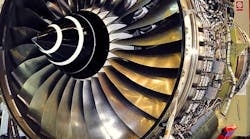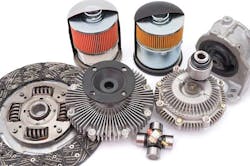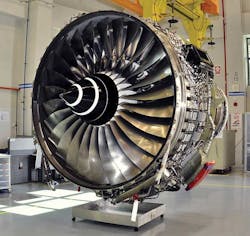This article was updated May 11, 2023. It was originally published June 1, 2017.
Engineers often design structures and components out of metals such as steel and aluminum because of their strength and durability. They now have an alternative, metal-matrix composites (MMCs), that perform better than conventional metals and alloys. This is accomplished by adding materials in the form of particles, fibers and even hollow micro-balloons into the matrices of the metals or alloys where they serve the same function as fibers and threads in fiberglass; they add strength and durability.
For example, adding boron, carbon, silicon carbide, alumina or graphite particles as reinforcement to aluminum results in a composite 30% to 40% stronger and more rigid than aluminum.
READ MORE: Composite Materials Increase Electric Current Capacity of Copper Wires
About a decade ago, metallurgists began experimenting with using nanoparticles as reinforcements in MMCs. These MMCs lower the mass and weight of components and assemblies while also improving their reliability and efficiency. And these characteristics can be improved without changing the materials’ chemical composition. For example, adding nanoparticles to aluminum makes a nano-composite that is more rigid than the original aluminum.
Other benefits of MMCs include:
- Higher temperature and fire resistance.
- Transverse stiffness and strength.
- No moisture absorption.
- Higher electrical and thermal conductivities.
- Better radiation resistance
Automotive MMCs
Automakers are increasingly turning to MMCs to meet strict fuel-economy requirements. Lighter MMCs let them boost fuel economy without sacrificing consumer demands for comfort and safety. Researchers at the Center for Composite Materials, the Center for Advanced Materials Manufacturing, and the University of Wisconsin Milwaukee (UWM) are working on manipulating MMCs to create lightweight materials with a range of beneficial properties for the auto industry. They are also pushing the envelope, trying to create MCCs that are self-repairing, self-cleaning and self-lubricating.
READ MORE: Ceramic-Matrix Composites
For example, engineers on the UWM team developed lead-free aluminum and copper matrix composites that contain graphite particles to reduce weight and maintenance They developed an MCC that can replace standard copper and lead used in crankshaft main bearing caps. The MMC bearings are far lighter and more wear-resistant than traditional materials such as lead. In addition, the graphite particles create a continuous film that makes the bearings self-lubricating. As an added bonus, graphite is nontoxic, unlike lead.
The UWM team also applied MMCs to another automotive problem. In conventional engines, aluminum pistons and cylinder liners sometimes stick together during cold start-up or when engine oil is low. To prevent this, the team developed an MCC that contains graphite particles in its aluminum matrix. The metal is strong enough to handle the application and the graphite provides built-in anti-seizing protection.
Automotive disk brakes and brake calipers (typically made of cast iron) are another area where MMCs can significantly reduce weight, which is critical for future electric vehicles. The UWM team used silicon carbide particles in an aluminum matrix to improve machinability and lower costs for these brake components. They have also looked at adding fly ash, a waste product from burning coal, to aluminum to make an MMC for brake rotors.
READ MORE: Are Nano-Metals Dead on Arrival?
As an additional cost reduction, the team is also developing synthesis methods that make use of waste materials. The team has coadded fly ash to aluminum and lead to make inexpensive, lightweight composites known as syntactic foams. The foams have low densities but high impact resistance.
Aerospace MCCs
Some 50 years ago, aircraft designers began taking advantage of the high strength-to-weight ratio associated with carbon composites. They started swapping out aluminum parts for composite versions. This lowered the aircraft’s weight and increased its fuel efficiency. Composites also resisted wear and corrosion.
Progress had continued and a variety of MMCs are used in many aircraft. For example, almost a third of the F-22 fighter’s structure is made of various carbon fiber composites and related materials. And newer F-16 Falcons are equipped with a structural landing gear component made of a titanium MMC with monofilament silicon carbide particles embedded in it.
Many of the sophisticated capabilities of military aircrafts would not be possible without MMCs and other composites. For instance, the V-22 Osprey, a tilt-rotor craft, can take off, land, and hover like a helicopter, as well as tilt its rotors forward 90 deg. in midair to fly like a turboprop plane. That’s thanks in part to lightweight graphite-fiberglass rotors and composite structures in the rotor subsystem. These structures are strong enough to withstand high centrifugal forces and still remain slightly flexible. Similarly, the F/A-18 Hornet’s aerial maneuverability stems partly from the composites used in is wings, flaps and stabilizers.
What’s Next?
One of the most fascinating developments by the UWM team is the work being done to develop self-repairing MCCs. These materials will be able to repair cracks and voids. One approach they’re trying uses shape-memory materials. The proposed MMC would have shape-memory wired embedded in the metal matrix. Then, if a small crack forms, the area would be heated and wires that happened to stretch across the crack would shrink in length, pulling the edges of the crack together.
The research team is also developing MMCs with self-cleaning components that could improve safety, along with reducing maintenance for cars and trucks.
READ MORE: Metal-Matrix Composites
Most processes used to make MCCs, such as vapor-phase and mixing and pressing composites, tend to be expensive. Researchers plan on fixing that. The UWM group, for example, has developed low-cost, liquid-based methods in which fibers or particles are added to the metal when it is molten. The hot mixture is poured into a mold where it cools and solidifies. These methods are well suited to making large, complex parts.
As research and development of MMCs materials continues, their use will likely also continue to expand into a wide variety of industries and applications.
Tom Barrett was brand marketing manager for McShane Welding and Metal Products when this article was originally published.


